Storm and Budapest capture
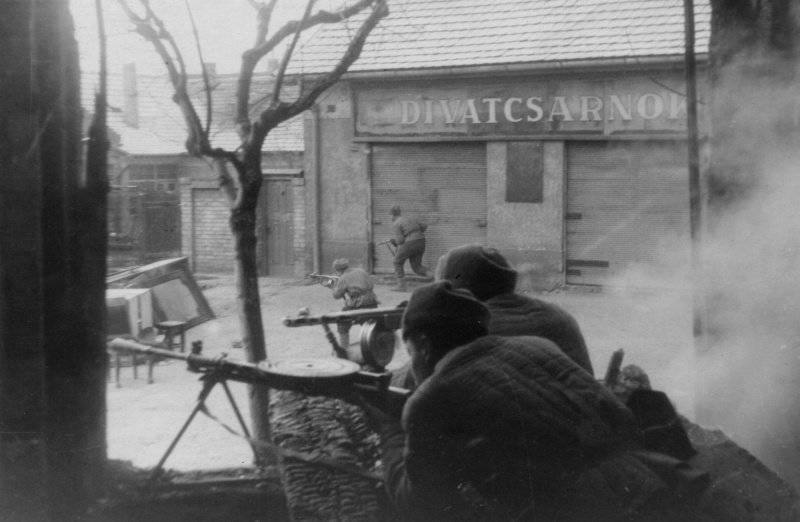
13 February 1945 stopped the resistance of the enemy's Budapest group. In captivity surrendered over 138 thousand soldiers and officers. The assault and the capture of Budapest was carried out by the Budapest group of Soviet troops under the command of General I. M. Afonin (then I. M. Managarov) as part of the Budapest operation. City defended 188-thousand. German-Hungarian garrison under the command of General Pfeffer-Wildenbruch.
During the Budapest operation on December 26, 1944, the troops of the 2nd Ukrainian Front under the command of Marshal R. Ya. Malinovsky and the 3rd Ukrainian Front of Marshal F.I. Tolbukhin surrounded the capital of Hungary. The enemy garrison was offered to surrender, but the ultimatum was rejected, and the parliament was killed. After this, a long and fierce battle began for the Hungarian capital. Of the European capitals taken by the Red Army, Budapest took first place in the duration of street battles. This was due to the difficult operational situation on the outer ring of the environment, where the German command repeatedly tried to break through the ring of the environment using large mobile armored formations. In addition, the Soviet command, wishing to preserve architectural monuments and not cause severe damage to the city, avoided using heavy artillery and assault Aviation, which delayed the course of hostilities.
18 January 1945. Soviet troops took the left bank of the Hungarian capital - Pest. In the right-bank part of the Hungarian capital, the hilly Buda, which was turned into a real fortified by the German-Hungarian troops, the fierce street battles continued for almost four weeks. Only after the failure of another attempt by the German command to unblock the surrounded garrison (by February 7) the Budapest group, having lost hope of liberation, February 13 surrendered. 138-thousand was taken prisoner. man, whole army.
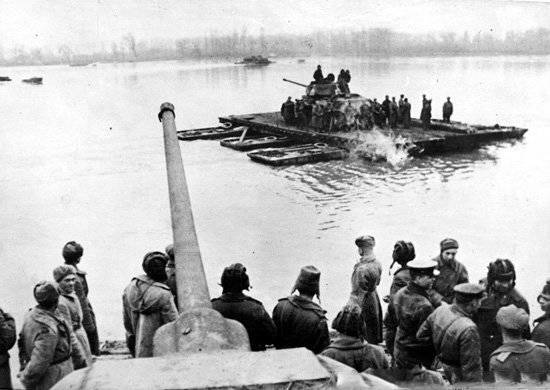
The beginning of the siege of Budapest
During October 1944, the Red Army troops during the Debrecen operation occupied about a third of the territory of Hungary and created the prerequisites for an attack on Budapest (Battle for hungary) The headquarters decided to continue the offensive by the forces of the 2nd and 3rd Ukrainian fronts. The shock group of the 2nd Ukrainian Front under the command of Marshal Rodion Malinovsky (46th Army of Shlemin reinforced by the 2nd Guards Mechanized Corps, 7th Guards Army Shumilov, 6th Guards tank army Kravchenko) October 29-30 went on the offensive in the Budapest direction. During November 1944, Soviet troops broke through the enemy’s defenses between the Tissa and Danube rivers and, having advanced up to 100 km, reached the outer defensive contour of Budapest from the south and southeast. Meanwhile, the troops of the 3rd Ukrainian Front, having defeated the opposing enemy forces, captured a large bridgehead on the west bank of the Danube. After that, the troops of the center and the left wing of the 2nd Ukrainian Front received the task of creating an encirclement around the Hungarian capital.
During the fierce battles in the period from 5 to 9 in December, the formations of the 7-th Guards, 6-th Guards Tank armies and the cavalry-mechanized group of Lieutenant-General Pliev intercepted the northern communications of the Budapest group. However, from the west, the city could not be circumvented immediately. When units of the 46 Army on the night of December 5 began to force the Danube, they could not achieve surprise. Enemy troops with a strong machine-gun artillery fire destroyed most of the boats. As a result, the forcing of the water barrier was delayed until December 7. The slowness of the troops of the 46 Army allowed the enemy to create a solid defense at the turn of Erd, Lake Velence. In addition, south-west, at the turn of the lake. Velence, Lake Balaton, the Germans were able to stop the 4 th Guards Army of Zakharov from the 3 of the Ukrainian Front.
December 12 Soviet Stake clarified the tasks of the two fronts. The Soviet armies were supposed to complete the encirclement and defeat of the Budapest group by joint attacks from the north-east, east and south-west, and take the Hungarian capital, which was turned into a real fortified area with three defensive lines. Malinovsky launched an offensive on the direction of the main attack of the 6 th Guards Tank and 7 th Guards armies. In this case, the tankers attacked in the first echelon, having a separate line of attack. December 20 Soviet tankers broke through the enemy defenses and the 5-th Guards Tank Corps by the end of the day captured the crossings to the river. Hron in Kalnitsa. After that, two tank and two mechanized brigades rushed south to support the offensive of the 7 Guards Army.
On the night of December 22, the German command, concentrating parts of the 6, 8 and 3 tank divisions in the Sakalosh area (up to 150 tanks), launched a strong counter-attack from the south on the flank of the Soviet tank army. German troops were able to break through to the rear of the 6 Guards Tank Army. However, the Soviet shock wedge continued the offensive and went directly to the rear of the German tank group. By the end of December 27 as a result of the joint efforts of the Soviet tankers and infantry, the German troops were defeated. In addition, the troops of the 7-th Guards and 6-th Guards Tank armies, developing an offensive in the western and southern directions, reached the north bank of the Danube and started fighting on the outskirts of Pest.
The troops of the 3 of the Ukrainian Front also resumed the offensive of 20 in December of 1944. However, the units of the 46 and 4 of the Guards armies could not break through the enemy defenses. Commander Tolbukhin brought into motion mobile units - 2-th Guards and 7-th mechanized corps of Major General Sviridov and Katkov. However, the commissioning of these compounds also did not lead to a decisive result. I had to throw into the battle another mobile unit - the 18-y tank corps of Major General Govorunenko. After that, the German defense managed to break through. Part of the 18 tank corps overcame the enemy's army defense line and, developing an advance in the north, 26 December liberated Esztergom. Here, the tankers of the 3 of the Ukrainian Front established contact with the troops of the 2 of the Ukrainian Front.
Meanwhile, parts of the 2 Guards' Mechanized Corps reached the western edge of Buda. Thus, the encirclement of the Budapest group was completed. 188-thousand has got to "boiler" enemy group, consisting of various German and Hungarian units and divisions.
At first, both sides overestimated each other’s forces, so the Soviet side did not undertake attacks, and the German-Hungarian side did not counterattack. There were gaps in the encirclement ring, through which some German-Hungarian units escaped. In the evening of December 25, the last suburban train left the Hungarian capital, filled to capacity with various Salashist functionaries who were afraid of fair punishment. The local Hungarian population, tired of the war and for the most part hated by the Salashi regime, almost everywhere welcomed the Red Army.
Doubts of the German-Hungarian command
The German and Hungarian military commanders believed that Budapest should not be defended in conditions of complete encirclement. The commander of Army Group South, Johannes Frisner, appealed to the High Command to withdraw German troops to the west bank of the Danube if the defense line was broken through by the Red Army units. He wanted to avoid protracted and bloody street fighting at any cost. At the same time, he rested not on military factors, but on anti-German sentiments that prevailed among the inhabitants of Budapest and the possibility of a revolt of the townspeople. As a result, the German troops would have to fight on two fronts - against the Soviet troops and the insurgent citizens.
The Hungarian military command also considered it possible to defend the capital only in the defense zone of the Attila Line. After the breakthrough of the defensive line and the threat of encirclement, the city was not planned to defend. The “national leader” of the Hungarian state, Ferenc Salash, who seized power after the overthrow of Admiral Horthy (he decided to conclude a separate truce with the USSR), immediately after coming to power, said that from a military point of view, it would be more profitable to evacuate the population of the capital and withdraw troops to mountainous areas. When the Soviet troops rushed to Budapest, Salashi took practically no measures to strengthen the defense of the city. Salashi did not focus on the defense of the Hungarian capital. This was connected not only with the possible destruction of the old city, but also with the danger of the uprising of the population (its Hungarian Führer called "the rabble of the big city"). To suppress the population of the capital, neither the Germans nor the Hungarians had free forces, all the combat-ready units fought at the front. In December, Salashi once again raised the issue of the defense problem of Budapest. However, his question remained unanswered.
The only figure who insisted on the defense of Budapest was Adolf Hitler. However, his voice was the most significant. 23 November 1944, the Fuhrer issued an order (after it was followed by a whole series of similar instructions) about the need to fight for each house and not to reckon with losses, including the civilian population. December 1 Hitler declared Budapest "fortress". The commandant of the city was appointed the supreme leader of the SS and the police in Hungary, the general of the SS troops, Obergruppenführer Otto Winkelman. The 9 SS Mountain Corps, commanded by the Obergruppenführer SS Karl Pfeffer-Wildenbruch, handed him over to the subordination. He, in fact, became responsible for the defense of the capital of Hungary. His main task was to prepare the capital for the upcoming assault. Each stone house was to become a small fortress, and the streets and neighborhoods were turned into bastions. To curb possible civil unrest, units of the German and Hungarian gendarmerie were subordinated to the command of the SS corps. The military police was mobilized. In the city commandant's office began to form special units. From the rear men (drivers, cooks, secretaries, etc.) began to create consolidated companies. So in the division "Feldkhernhalle" was formed 7 pivot company, in the 13-th tank division - 4 company.
Thus, Berlin ignored the interests of the Hungarian people. The wishes of the Hungarian leadership to make Budapest an “open” city and to save it from destruction were rejected. The German ambassador Edmond Fezenmayer, who served as the special representative of the Führer, put it very clearly: "If this sacrifice will allow to keep Vienna, then Budapest could be destroyed more than a dozen times."
The opinion of the German command on the defense of Budapest also did not take into account. Although Frisner repeatedly tried to get permission from the German headquarters to change the front line in the interests of the army group. However, the entire proposal was strongly rejected. There was no doubt about the possibility of holding the capital of Hungary in command of Army Group South. 1 December Friesner ordered the evacuation of all military institutions and civilian services under his command from the city. The remaining services were to be fully prepared for evacuation. The commander of the 6 of the German army, General Maximilian Fretter-Picot, proposed to withdraw beyond the "Attila Line" to avoid the threat of encirclement. Hitler forbade retreat. Soon Frisnera and Fretter-Pico were removed from their posts.
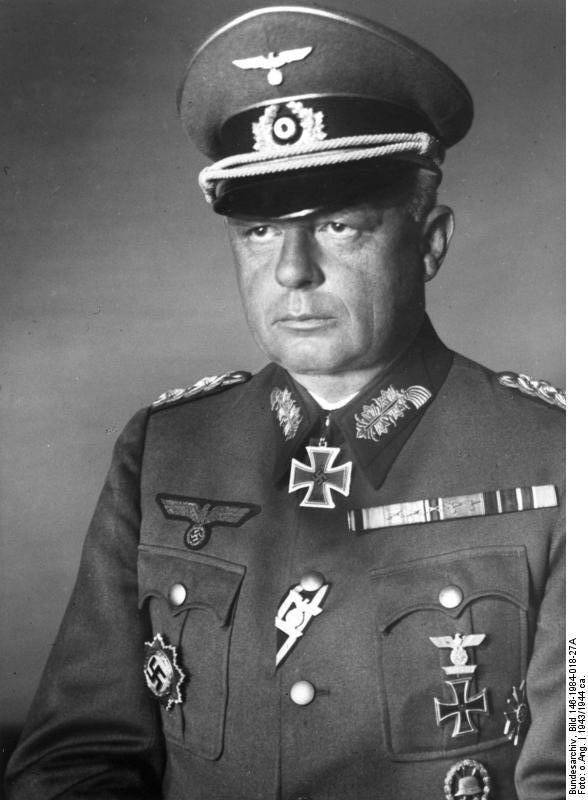
Army Group Commander Yug Johannes Frisner
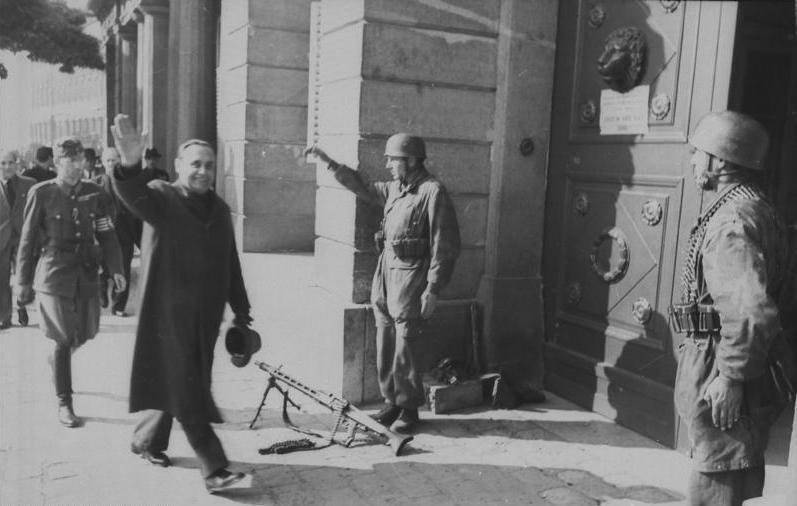
Hungarian Fuhrer Ferenc Salash in Budapest. October 1944
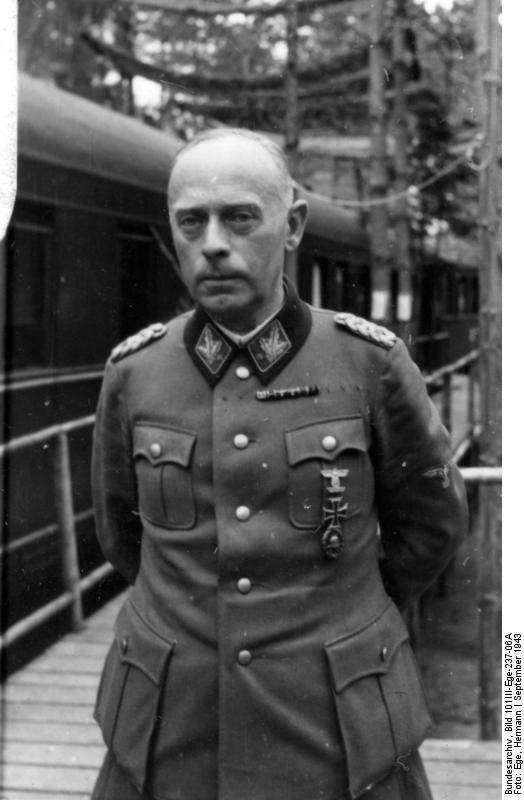
The commander of the 9 SS Mountain Corps, responsible for the defense of Budapest, Karl Pfeffer-Wildenbruch
The forces of the Budapest grouping. Its combat effectiveness
The structure of the surrounded Budapest group consisted of: German 13-I tank division, tank division Feldkhernhalle, 8-I and 22-I Cavalry SS divisions, part of the 271-th Grenadier Division, and 9 part of the rifle squadron unit. detachments, SS 1 police regiment, Europe battalion, heavy anti-aircraft artillery division (12 guns), 12 assault air defense artillery regiment (48 guns) and other units.
Hungarian troops: 10-Infantry Division, 12-I reserve division, riot units, 1-I tank division, part of the 1-th Hungarian Hussars Division, part of the 6-th division of self-propelled guns (30-32 SAU), Syunion divisions, Zi-Zi division of self-propelled guns (168-20 SAU), divisions, Syros, Zi-X divisions, self-propelled guns ), army gunners (30-XNUMX guns), five gendarmes battalions and a number of individual units and formations, including the Hungarian militias.
According to the Soviet command in the area of Budapest, 188 thousand people were surrounded (of which 133 thousand people surrendered in captivity). The reports of the command of Army Group South reported at the end of 1944 in the Hungarian capital got into the "cauldron" about 45 thousand German soldiers and officers and 50 thousand Hungarians. The command of the Budapest grouping did not have accurate data about its forces. As the chief of staff of the 1 Army Corps, Sandor Horvath, noted, over the course of seven weeks he “did not encounter plausible data on the number of combat units, the number at their disposal weapons and ammunition. There was not even a scheme for identifying registered and unrecorded parts. ” Actually, the management of the 1 Army Corps did not have in its composition of troops, except the battalion "Budapest", which was engaged in the protection of important urban sites. In addition, it is difficult to consider volunteers. So in January 1945, many Hungarian students, cadets, high-school students and teenagers who succumbed to propaganda became the most volunteers.
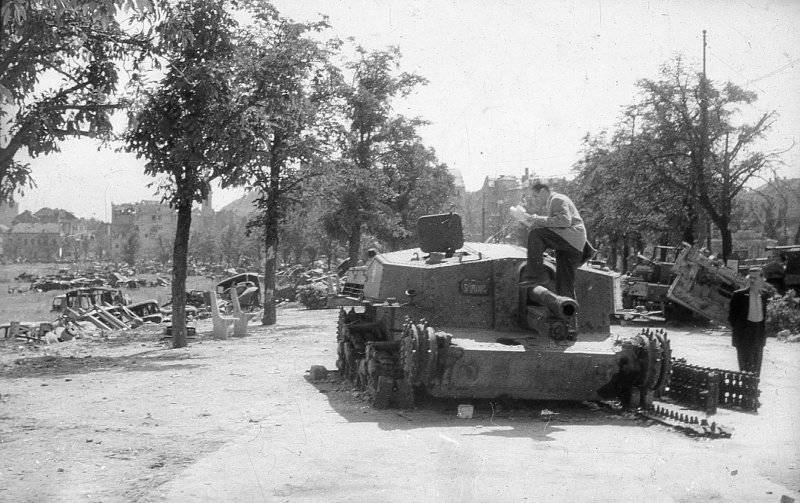
Hungarian SAU "Zriny" II (40 / 43M Zrínyi) on the street of Budapest
A significant part of the Hungarian troops, who were surrounded, tried to avoid battles and checks. Some units capitulated at the very beginning of the operation. The Hungarians were demoralized by the loss of the war, many hated the Germans. Therefore, the Hungarian commanders tried to underestimate the number of soldiers and weapons at disposal, so that the German command did not assign them dangerous tasks. The Hungarians preferred German troops to fight in dangerous areas. For example, the Hungarians stated that by 14 in January 1945 the number of 10 infantry and 12 reserve divisions had decreased to 300 people, although the supply documents showed that only 10 division absorbed provisions for 3,5 thousand people. That is, only one division of the numbers were understated by more than 10 times! Hungarian commanders believed the battle for Budapest was lost and did not want to shed blood. As a result, no more than a third of Hungarian soldiers participated in the battles.
Many Hungarian units had poor combat capability, were poorly trained and armed. So just before the siege began to form a special police combat units. Many of the police themselves expressed a desire to protect the city. As a result, about 7 thousand people enrolled in these units. However, the police did not have combat skills and, when confronted with army units, in the very first battles they lost up to half of the killed and wounded.
In addition, many Hungarian soldiers were not ideological fascists, therefore, at the first opportunity they surrendered. Such units the Germans feared to throw into battle, so as not to worsen the situation. An example of such a unit was the 1-I Hungarian Panzer Division. In just two weeks in December, 80 deserted people in the division. Moreover, the division command was not going to conduct even a formal investigation, and no criminal cases were opened against the deserters. During the siege of the capital, the command of the division itself was seated along with the 6-m reserve regiment in warehouses and sat there until the end of the fighting. A similar position was taken by other Hungarian commanders who imitated the fight. In fact, the Hungarian officers no longer wanted to fight and only wanted to survive this battle. At the same time, the Hungarian troops suffered greater "losses" than the actively fighting German troops, they just gradually went home. The German and Hungarian command apparently knew about it, but put up not to get a mutiny in the rear. In addition, the German commanders were able to lay the blame for the defeat on the Hungarians.
The most combat-ready part of the Hungarian part of the Budapest grouping was the divisions of self-propelled artillery installations (about 2 thousand people and 30 machines). These soldiers had combat experience and fought well.
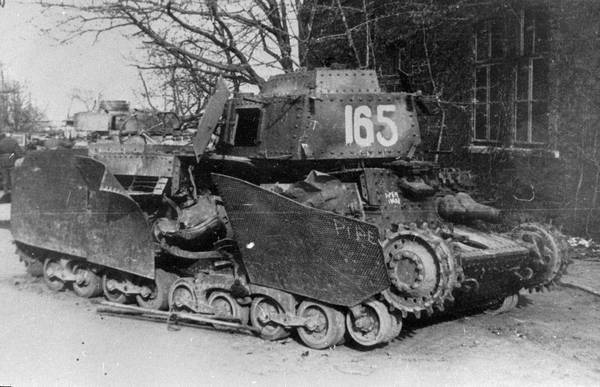
Hungarian Turan II tank with screens on the tower and the hull in the suburb of Budapest. February 1945 of the year
Therefore, the whole weight of the siege of Budapest had to be borne by the German troops. In terms of their morale, skill, and weaponry, they were far superior to the Hungarians. True, this did not mean that all German soldiers demonstrated high combat capability. Thus, the German SS units recruited from Hungarian Volksdeutsche, often not only did not speak German, but also did not want to die for Great Germany. They most often deserted. Therefore, it was necessary to create barrage detachments. Machine gun crews shot without any warning those who tried to escape from the battlefield.
The fighting core of the German grouping was the 13-I tank division, the Feldhernhalle division and the SS 8-Cavalry division. These units had a great combat experience, they had many volunteers, members of the Nazi party. Therefore, these units fought to the death.
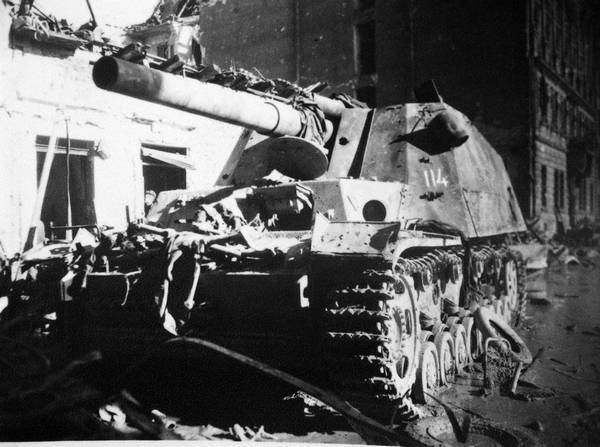
150-mm heavy self-propelled howitzer "Hummel", lined with Red Army units on Budapest Street. February 1945 of the year
To be continued ...
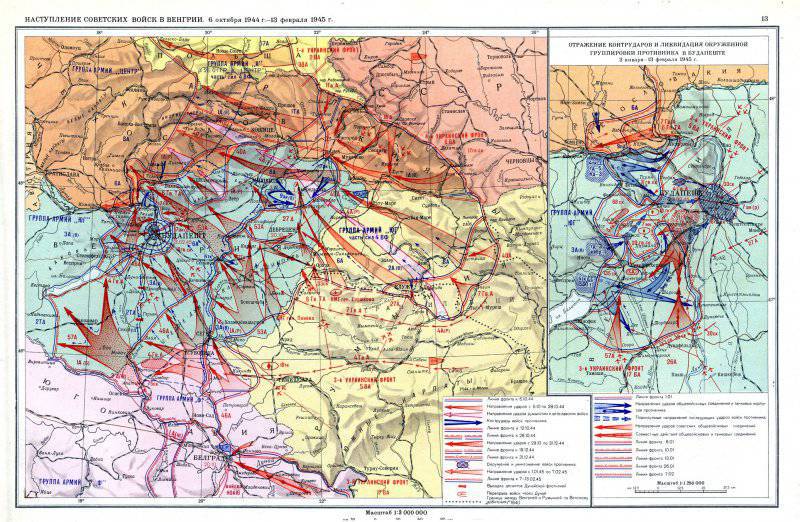
Information